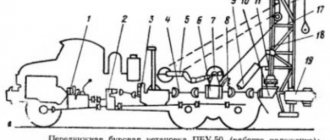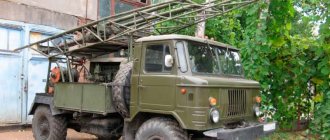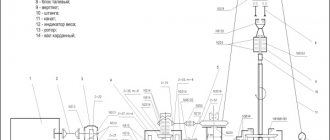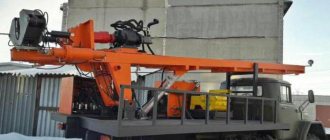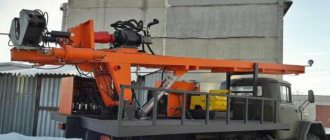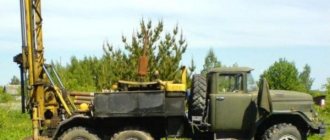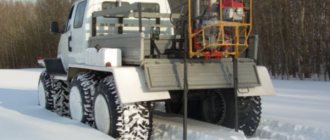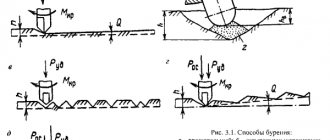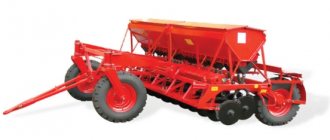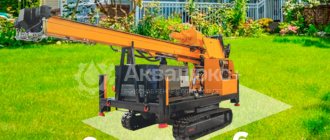There are several basic technologies and methods used today for constructing reinforced and unreinforced bored concrete piles. Accordingly, the drilling complexes used in the work for rotary cyclic and continuous drilling of the SO, BIS, BSO, URP, USG and MBS models also differ.
Our company specializes in driving piles for foundations; the equipment available for rent is on the page: Our equipment.
Drilling rigs for bored piles
- SO is a self-propelled base and a pile driver drilling system with an auger, a telescopic rod and a mechanical extender (the complex is additionally equipped with a removable bucket drill).
- BIS-3M is a drilling injection pumping unit with a hollow auger, “injecting” a sand-containing mixture or water-cement mortar.
- BS is a crane-based drilling complex with a removable bucket drill, a grab for cleaning the mouth of a vertical pile well and a hydraulic bit, drilling under the protection of metal casing lock pipes.
- URP-1 - a base and a cylindrical bucket drill, located not on the base, but separately, on a rigid support table.
- USG-10 is a rotary-type base and vertical drilling system with a hydraulic casing table and a Kelly bar.
- MBS-1.7 - a base with a bucket mounted drill and a mechanical grab, with clay reinforced walls of the working well. Other types of soil drilling installations are derivatives of the main ones mentioned above.
Specifications
| Recommended drilling depth: | |
| Drill rod | Well depth, m |
| B | 1640 |
| N | 1260 (1680 when using lightweight N drill pipe) |
| H | 855 (1150 when using lightweight H drill pipe) |
| P | 555 (790 when using lightweight P drill pipe) |
| Rotator load capacity, tons | 15 |
| Winch lifting capacity, tons | 10 |
| Maximum torque, Nm | 6000 |
| Speed range, rpm | 0-1270 |
| Rotator stroke, m | 3,25 |
| Weight, t | up to 7 |
| Dimensions in working position (90˚) LxWxH, mm | 4940x2400x10220 |
| Dimensions in transport position LxWxH, mm | 6860x2400x2300 |
| Control system | ZBO Drill Control |
| Additional options | Possibility of delivering the drilling rig on tracks, on wheels, in a drilling building |
Turnkey ZBO complex
Drilling rig ZBO S15
CO-2 drilling rig for bored piles
It is used for drilling preliminary (leading) wells and manufacturing concrete bored (diameter up to 600 mm) reinforced and non-reinforced piles with a heel widened to 1600 mm and a length of 29-30 m without the use of casing lock pipes.
It is an equipment (machine) for attaching a telescopic type drill string with an auger drill (equipped with drilling bits for various heavy soils) and guides for the carriage and cleaner to a pile driver stand, electrically driven from an external network. To widen the load-bearing base of the pile, a separate attachment is used, consisting of a three-blade mechanism with a container for soil.
To move the complex around the construction site, a crane or a full-rotary excavator on crawler tracks is used.
Where is CO-2 used?
- when drilling with the installation of reinforced and non-reinforced piles in dense soils, if necessary, with widening the “heel” of the pile;
- when drilling pile holes in unstable flooded soils with reinforcement with clay and using a conductor to guide the bucket. Cyclic (well - dump - well) drilling process.
Distinctive features
1 Telescopic mast
The patented telescopic mast reduces work time and resources during drilling preparation and completion. Allows you to work with candles 6 m long.
2 Monitoring and recording system ZBO Drill Control
The usual hydraulic control of the ZBO S15 drilling rig is supplemented with electronic control - ZBO Drill Control. This system allows you to display on the screen in real time the technological characteristics of the drilling process (torque on the rotator, N.m; rotator speed, rpm; column weight, kN; bottom hole force, kN; recess index, rpm; drilling fluid pressure, bar; fuel level in the tank, %; fuel consumption, l/min; engine speed, rpm; coolant temperature, °C; engine operating hours; battery voltage, V; indication of engine oil pressure; indication of engine errors; indication of errors in drilling rig sensors; self-testing of measuring equipment), as well as recording and storing them during operation with the ability to transfer them to a USB drive.
3 Use of large diameter pipes for casing
The design of the drilling rig provides the following features:
- folding rotator with a stroke of 3.25 m, with an additional cooling circuit and a reinforced 3-row chain;
- a folding pipe holder of a wedge design ensures retention of the column in the absence of pressure in the hydraulic system.
4 Cable support system
A reliable, metal structure located on the match is designed to provide mechanical protection and extend the service life of the hose.
5 Convenient change of drill bit
The 1.3 m mast movement on the bottom carriage makes it easy to change the drill bit.
6 System of uniform cable winding on the SSK winch
Provides uniform winding of the cable, facilitating more uniform operation of the winch and increasing the service life of the cable.
7 Complex delivery
Possibility of supplying a drilling rig with a set of drilling tools and related equipment (drill pipes, diamond drill bits, necessary reagents for drilling fluids).
8 Facilitate the installation and removal of drill pipes
As an option, the customer can be offered a system for mechanizing the process of working with drill pipes.
9 Equipment according to customer requirements
The drilling rig can be installed on any chassis with a lifting capacity of over 10 tons, with power take-off from the chassis or with the installation of an additional engine. It is possible to manufacture a drilling rig in a special shelter, which in the transport position does not exceed 2.5 m in size, and 3.7 m in the working position.
Advantages of the device
The advantages of the product are as follows:
- very low price;
- extra long service life, verified in fact;
- durable housing;
- the ability to replace worn parts and their quality;
- ease of data collection;
- presence of protection against magnetic influence (for modification 2M).
There are also a lot of disadvantages, but a device with such a history cannot but have them. Large dimensions are not the most significant drawback compared to reliability, which has successfully passed the test of time.
We recommend: Electricity meter Neva MT 113 - characteristics and description of the device
Types of well drilling
You can drill a water well on a personal plot or summer cottage using one of the following types:
- Auger.
- Rotary.
- Shock-rope method (see Do-it-yourself well using the shock-rope method: how to set it up correctly).
The listed drilling technologies differ from each other in the methods of rock destruction and methods of extracting soil structures from the shaft. In each case, certain equipment is used, which affects the quality differently, which determines the final price of the work. Each method of the process can be seen in the video. This article discusses in more detail the issues of drilling wells using the auger method, and the features that an auger well pump has.
Physical properties
| Physical state | At normal pressure and temperature it is a gas; at a temperature less than –78°C it is a solid; it can only take on a liquid state at high pressure. |
| Density | 1.84 kg/m3 – under normal conditions: temperature +20°C, pressure 101.3 kPa |
| Boiling temperature | –78, 45°С |
| Triple point | – 56.6°С, equilibrium pressure for it – 0.517 mPa |
| Ability to dissolve in water | 1600 mg/l |
| Fire hazard | safe |
| Explosion hazard | safe |
| Stability | Stable |
| Chemical activity | Inert gas |
| Toxicity | Non-toxic |
| Harm to the environment | Harmless |
| fire extinguishing agents acceptable for use in areas where carbon dioxide cylinders are located | Any |
Areas of application
- in mechanical engineering, providing cold fit of elements of various mechanisms;
- for fine sharpening of cutting parts of mechanisms;
- when performing electric welding work, preventing contact of heated metal with the surrounding air;
- in metallurgy - casting molds blown with carbon dioxide cool faster and more accurately retain the given shape;
- in the production of carbon dioxide fire extinguishers, which prevent the spread of fire more effectively than traditional foam;
Casing
The rocks intersected by the well are partially strengthened through the use of clay solution, but complete prevention of collapsing of the excavation walls is achieved by casing them with steel pipes. Having completed drilling in a given interval, the drilling of the well is suspended for installation of the casing . The part of the structure closest to the surface is called the conductor.
When strengthening the walls of the mine, adhere to the following rules:
- the diameter of the casing pipe must be less than the cross-section of the excavation: the column is lowered into the well freely;
- the depth from which a break in drilling is made to install casing is in the range of 30-600 m;
- the walls of the water intake excavations are lined with seamless pipes 6-13 m long; welded risers Ø426-478 mm are used to make the conductor;
- the annulus is filled with cement cement mixture.
In difficult geological conditions, several casing columns of different diameters are installed. Smaller pipes are located in deep horizons.
The peculiarity of the lower link of the structure is that this pipe is operational and is perforated to allow water to penetrate inside the column.
Casing
Design
The installation is based on a base machine in the form of a crane. The attachment includes a guide in the form of a pipe with a carriage moving along it, thanks to an electric drive. The output shaft of the electric drive is connected to a telescopic drill string equipped with a cleaner. The column is made up of two sections. Screw blades are located along the entire length of the lower section. When the installation is in operation, the soil is destroyed by a three-flute drill bit located at the end of the auger, or a screw drill.
Photo of drilling rig SO-2
The usual diameter of wells is 600 mm, their depth is up to 30 meters. The diameter of the widened cavity for installing piles is 1600 mm.
Equipment and sequence of work
The lifting capacity of the base crane for installation is 25 tons. Drilling wells no deeper than 12 m is performed without extending the rod. When a well up to 22 meters is to be drilled, the lower section of the drill string is moved apart. To drill up to 30 meters, both sections are moved apart.
When the first 6 meters of depth are drilled, the auger transports the soil to the surface, and the soil is removed manually. When the depth exceeds 6 meters, the auger removed from the ground must be periodically freed from adhering soil with a cleaner. According to technical standards, drilling can be done layer by layer (if the soils are heterogeneous) or to the full depth (if the soils are homogeneous throughout the entire length of the well).
To carry out the work of widening the base for piles, use a special widener of the flow section.
Moving the installation from one well to the next:
- moving from one drilling site to the next;
- preparing the sleeper cage for the guide boom;
- dismantling the sleeper cage.
Installation operation:
- the auger is lowered into the well;
- if necessary, extend the bar;
- perform drilling;
- assemble the telescopic rod;
- remove the auger from the well;
- install the auger cleaner;
- clean the auger;
- remove the auger cleaner and return the boom to the drilling site.
To work on the rig, the team must include at least two people: a drilling rig operator (5th grade) and an assistant operator (4th grade).
